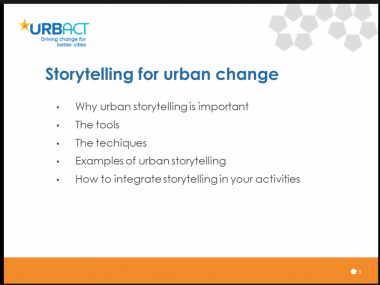Telling the story of Gendered Landscapes
Edited on
17 March 2022Cities are places with inherent power structures and challenges but also places where innovations and solutions arise. How do we communicate the nuances and the complexity of cities in a comprehensive and engaging way? How do we revive the spirit of the physical place and the ownership of integrated strategies for our cities? On our transnational meeting with the Gendered Landscape network in March, we had an afternoon with a focus on how to tell the story of the Gendered Landscape. The workshop was led by Simone D’Antonio, URBACT expert on storytelling.

Simone D’Antonio explains that storytelling is based on a will to promote urban innovation with a different lens on challenges, methods and initiatives, and therefore a useful tool for presenting and raising awareness of new perspectives. Common elements of storytelling are not surprisingly a focus on stories, but also, the use of data, innovative sources of information, catchy formats as well as a strong connection with social media. Storytelling is an important tool because it fosters the connection among different levels of government and citizens and hence, it can promote civic engagement and the role of collaboration between citizens and local authorities.
One example of city-based storytelling brought forward by Simone D’Antonio, is ATM uncovered in Milan. It is a series of documentaries on the “behind the scenes” of public transport in the city of Milan. It gives a narrative for the role of public transport in the everyday life of the city, a comfort many citizens might have taken for granted. However, by presenting it with a narrative tone, public transport has turned into a subject that foster community spirit.
During the workshop, each city got to design their own storytelling connected to their integrated action plan or their small-scale action. All cities in the network are trying to foster engagement by making gendered power structures visible in their local context. Including gendered power structures on the labour market, in the emergence of smart cities and in the way women and men use the urban space. Hence, all partner cities have a story to tell about their gendered landscape, and from this session, we bring with us a more diverse toolbox to do so.
Submitted by annika.dalen@umea.se on
